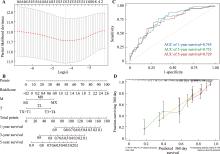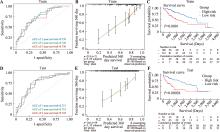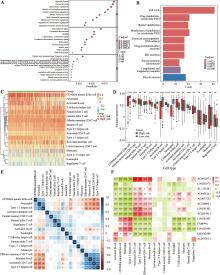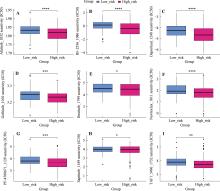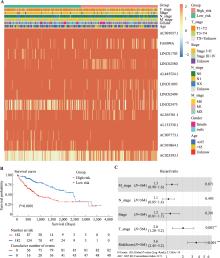Hereditas(Beijing) ›› 2025, Vol. 47 ›› Issue (4): 456-475.doi: 10.16288/j.yczz.24-208
• Research Article • Previous Articles Next Articles
Identification of PANoptosis-related lncRNAs in hepatocellular carcinoma based on bioinformatics and construction of a prognostic model
Rui He( ), Xiujuan Zheng, Ningning Wang, Xuying Li, Mingqi Li, Shijing Nian, Kewei Wang(
), Xiujuan Zheng, Ningning Wang, Xuying Li, Mingqi Li, Shijing Nian, Kewei Wang( )
)
- Center for Endemic Disease Control, Chinese Center for Disease Control and Prevention, Harbin Medical University, Harbin 150081, China
-
Received:2024-09-09Revised:2024-11-29Online:2025-04-20Published:2024-12-03 -
Contact:Kewei Wang E-mail:herui55555@163.com;keweiwang0718@163.com -
Supported by:National Natural Science Foundation of China(81773367);Scientific Research and Practice Innovation Fund for Postgraduate of Harbin Medical University(YJSCX2023-123HYD)
Cite this article
Rui He, Xiujuan Zheng, Ningning Wang, Xuying Li, Mingqi Li, Shijing Nian, Kewei Wang. Identification of PANoptosis-related lncRNAs in hepatocellular carcinoma based on bioinformatics and construction of a prognostic model[J]. Hereditas(Beijing), 2025, 47(4): 456-475.
share this article
Add to citation manager EndNote|Reference Manager|ProCite|BibTeX|RefWorks
Table 1
Construction of PANoptosis-related gene sets"
| 细胞死亡类型 | 基因 |
|---|---|
| 细胞焦亡 (Pyroptosis) | NLRC4、NLRP1、MEFV、PYCARD、GSDMD、CASP1、CASP5、NLRP3、AIM2、CASP4、CASP12、BAX、IRF1、GSDMB、GSDMC、GSDMA、NLRP6、ELAVL1 |
| 细胞凋亡 (Apoptosis) | CASP10、CASP8、CASP2、APAF1、ZBP1、CASP9、CASP6、CASP3、CASP7、TNFRSF1A、DCN、RNF31、TNFAIP3、MAP3K7、PSTPIP2、ADAR、DIABLO、NLRP9、NAIP、CYLD、STAT1、JAK2、IFNGR1、JAK1、TRADD、TBK1 |
| 坏死性凋亡 (Necroptosis) | RIPK3、RIPK1、MLKL、FADD、FAS、TNF、RBCK1 |
Table 2
Univariate and multivariate Cox regression analysis of PANoptosis-related lncRNAs in TCGA Cohort"
| 基因 | 单变量 | 多变量 | ||||
|---|---|---|---|---|---|---|
| HR | 95%CI | P.adj | HR | 95%CI | P.adj | |
| AC091057.1 | 1.18 | 1.06~1.32 | 0.007 | 1.05 | 0.87~1.26 | 0.894 |
| FAM99A | 0.95 | 0.90~0.99 | 0.029 | 0.98 | 0.92~1.05 | 0.894 |
| LINC01703 | 1.18 | 1.06~1.32 | 0.007 | 1.01 | 0.88~1.16 | 0.937 |
| LINC02580 | 0.85 | 0.74~0.96 | 0.014 | 0.93 | 0.79~1.09 | 0.829 |
| AL445524.1 | 1.22 | 1.07~1.39 | 0.007 | 1.13 | 0.95~1.35 | 0.765 |
| LINC01093 | 0.93 | 0.88~0.99 | 0.034 | 0.98 | 0.89~1.07 | 0.894 |
| LINC02499 | 0.91 | 0.85~0.98 | 0.014 | 0.95 | 0.87~1.04 | 0.765 |
| LINC02475 | 1.12 | 1.04~1.20 | 0.007 | 1.08 | 0.99~1.18 | 0.765 |
| AC109322.1 | 1.20 | 1.05~1.38 | 0.012 | 0.97 | 0.80~1.19 | 0.937 |
| AL365361.1 | 0.91 | 0.82~1.00 | 0.049 | 0.94 | 0.82~1.06 | 0.765 |
| AL133338.1 | 1.18 | 1.05~1.33 | 0.012 | 1.11 | 0.96~1.30 | 0.765 |
| FBXL19-AS1 | 1.15 | 1.02~1.3 | 0.029 | 0.99 | 0.84~1.17 | 0.937 |
| AC007773.1 | 1.21 | 1.07~1.36 | 0.007 | 1.03 | 0.85~1.23 | 0.937 |
| AC010864.1 | 1.30 | 1.10~1.55 | 0.007 | 1.13 | 0.90~1.41 | 0.765 |
| AC102953.2 | 1.20 | 1.04~1.38 | 0.014 | 1.00 | 0.84~1.20 | 0.983 |
| AC079174.2 | 1.21 | 1.05~1.40 | 0.012 | 0.93 | 0.75~1.15 | 0.894 |
| AC023593.1 | 1.30 | 1.14~1.49 | <0.001 | 1.13 | 0.92~1.39 | 0.765 |
Table 3
Univariate and multivariate COX analysis of risk scores and clinical characteristics"
| 变量 | 单变量 | 多变量 | ||||
|---|---|---|---|---|---|---|
| HR | 95%CI | P.adj | HR | 95%CI | P.adj | |
| Age | 1.27 | 0.90~1.80 | 0.267 | 1.07 | 0.75~1.54 | 0.757 |
| Gender | 1.23 | 0.86~1.75 | 0.332 | 1.06 | 0.74~1.52 | 0.757 |
| M_stage | 1.27 | 1.06~1.53 | 0.023 | 1.27 | 0.99~1.63 | 0.168 |
| N_stage | 1.23 | 1.03~1.48 | 0.043 | 1.09 | 0.86~1.39 | 0.720 |
| Stage | 1.79 | 1.42~2.27 | <0.001 | 1.16 | 0.79~1.70 | 0.720 |
| T_stage | 2.24 | 1.63~3.08 | <0.001 | 2.11 | 1.33~3.37 | 0.009 |
| Treatment | 1.17 | 0.70~1.97 | 0.589 | 1.49 | 0.90~2.47 | 0.266 |
| Treatment_type | 1.10 | 0.78~1.55 | 0.589 | 1.09 | 0.76~1.55 | 0.757 |
| RiskScore | 3.28 | 2.26~4.75 | <0.001 | 3.65 | 2.49~5.35 | <0.001 |
| [1] |
Vogel A, Meyer T, Sapisochin G, Salem R, Saborowski A. Hepatocellular carcinoma. Lancet, 2022, 400(10360): 1345-1362.
pmid: 36084663 |
| [2] |
Siegel RL, Miller KD, Fuchs HE, Jemal A. Cancer statistics, 2022. CA Cancer J Clin, 2022, 72(1): 7-33.
pmid: 35020204 |
| [3] |
Lang H, Sotiropoulos GC, Dömland M, Frühauf NR, Paul A, Hüsing J, Malagó M, Broelsch CE. Liver resection for hepatocellular carcinoma in non-cirrhotic liver without underlying viral hepatitis. Br J Surg, 2004, 92(2): 198-202.
pmid: 15609381 |
| [4] |
Eguchi S, Hara T, Takatsuki M. Liver transplantation for metastatic liver tumors. Hepatol Res, 2017, 47(7): 616-621.
pmid: 28371027 |
| [5] |
Dou JP, Liang P, Yu J. Microwave ablation for liver tumors. Abdom Radiol (NY), 2016, 41(4): 650-658.
pmid: 26880177 |
| [6] |
Bozkurt MF, Salanci BV, Uğur Ö. Intra-arterial radionuclide therapies for liver tumors. Semin Nucl Med, 2016, 46(4): 324-339.
pmid: 27237442 |
| [7] |
Yeung CSY, Chiang CL, Wong NSM, Ha SK, Tsang KS, Ho CHM, Wang B, Lee VWY, Chan MKH, Lee FAS. Palliative liver radiotherapy (RT) for symptomatic hepatocellular carcinoma (HCC). Sci Rep, 2020, 10(1): 1254.
pmid: 31988376 |
| [8] | Han Z, Luo W, Shen J, Xie F, Luo J, Yang X, Pang T, Lv Y, Li Y, Tang X, He J. Non-coding RNAs are involved in tumor cell death and affect tumorigenesis, progression, and treatment: a systematic review. Front Cell Dev Biol, 2024, 12: 1284934. |
| [9] |
Mohammad RM, Muqbil I, Lowe L, Yedjou C, Hsu HY, Lin LT, Siegelin MD, Fimognari C, Kumar NB, Dou QP, Yang HJ, Samadi AK, Russo GL, Spagnuolo C, Ray SK, Chakrabarti M, Morre JD, Coley HM, Honoki K, Fujii H, Georgakilas AG, Amedei A, Niccolai E, Amin A, Ashraf SS, Helferich WG, Yang XJ, Boosani CS, Guha G, Bhakta D, Ciriolo MR, Aquilano K, Chen S, Mohammed SI, Keith WN, Bilsland A, Halicka D, Nowsheen S, Azmi AS. Broad targeting of resistance to apoptosis in cancer. Semin Cancer Biol, 2015, 35(Suppl): S78-S103.
pmid: 25936818 |
| [10] |
Malireddi RKS, Tweedell RE, Kanneganti TD. PANoptosis components, regulation, and implications. Aging (Albany NY), 2020, 12(12): 11163-11164.
pmid: 32575071 |
| [11] |
Jiang MX, Qi L, Li LS, Wu YM, Song DF, Li YJ. Caspase-8: a key protein of cross-talk signal way in "PANoptosis" in cancer. Int J Cancer, 2021, 149(7): 1408-1420.
pmid: 34028029 |
| [12] |
Pandian N, Kanneganti TD. PANoptosis: a unique innate immune inflammatory cell death modality. J Immunol, 2022, 209(9): 1625-1633.
pmid: 36253067 |
| [13] |
Samir P, Malireddi RKS, Kanneganti TD. The PANoptosome: a deadly protein complex driving pyroptosis, apoptosis, and necroptosis (PANoptosis). Front Cell Infect Microbiol, 2020, 10: 238.
pmid: 32582562 |
| [14] |
Ocansey DKW, Qian F, Cai PP, Ocansey S, Amoah S, Qian YC, Mao F. Current evidence and therapeutic implication of PANoptosis in cancer. Theranostics, 2024, 14(2): 640-661.
pmid: 38169587 |
| [15] |
Karki R, Sundaram B, Sharma R, Lee S, Malireddi RKS, Nguyen LN, Christgen S, Zheng M, Wang YQ, Samir P, Neale G, Vogel P, Kanneganti TD. ADAR1 restricts ZBP1-mediated immune response and PANoptosis to promote tumorigenesis. Cell Rep, 2021, 37(3): 109858.
pmid: 34686350 |
| [16] |
Pan HD, Pan JX, Li P, Gao JP. Characterization of PANoptosis patterns predicts survival and immunotherapy response in gastric cancer. Clin Immunol, 2022, 238: 109019.
pmid: 35470064 |
| [17] |
Lin JF, Hu PS, Wang YY, Tan YT, Yu K, Liao K, Wu QN, Li T, Meng Q, Lin JZ, Liu ZX, Pu HY, Ju HQ, Xu RH, Qiu MZ. Phosphorylated NFS1 weakens oxaliplatin-based chemosensitivity of colorectal cancer by preventing PANoptosis. Signal Transduct Target Ther, 2022, 7(1): 54.
pmid: 35221331 |
| [18] |
Wei SY, Chen ZG, Ling XY, Zhang WT, Jiang L. Comprehensive analysis illustrating the role of PANoptosis- related genes in lung cancer based on bioinformatic algorithms and experiments. Front Pharmacol, 2023, 14: 1115221.
pmid: 36874021 |
| [19] |
Zhang JL, Zhao XH, Ma XJ, Yuan ZY, Hu M. KCNQ1OT1 contributes to sorafenib resistance and programmed death‑ligand‑1‑mediated immune escape via sponging miR‑506 in hepatocellular carcinoma cells. Int J Mol Med, 2020, 46(5): 1794-1804.
pmid: 33000204 |
| [20] |
Huarte M. The emerging role of lncRNAs in cancer. Nat Med, 2015, 21(11): 1253-1261.
pmid: 26540387 |
| [21] |
Jarroux J, Morillon A, Pinskaya M. History,discovery, and classification of lncRNAs. Adv Exp Med Biol, 2017, 1008: 1-46.
pmid: 28815535 |
| [22] |
Quinn JJ, Chang HY. Unique features of long non-coding RNA biogenesis and function. Nat Rev Genet, 2015, 17(1): 47-62.
pmid: 26666209 |
| [23] |
Wang P, Xue YQ, Han YM, Lin L, Wu C, Xu S, Jiang ZP, Xu JF, Liu QY, Cao XT. The STAT3-binding long noncoding RNA lnc-DC controls human dendritic cell differentiation. Science, 2014, 344(6181): 310-313.
pmid: 24744378 |
| [24] |
Wilusz JE, Sunwoo H, Spector DL. Long noncoding RNAs: functional surprises from the RNA world. Genes Dev, 2009, 23(13): 1494-1504.
pmid: 19571179 |
| [25] |
Hao LH, Wu WZ, Xu YK, Chen YF, Meng CZ, Yun JY, Wang XY. lncRNAs-MALAT1: a key participant in the occurrence and development of cancer. Molecules, 2023, 28(5): 2126.
pmid: 36903369 |
| [26] |
Nadhan R, Isidoro C, Song YS, Dhanasekaran DN. lncRNAs and the cancer epigenome: mechanisms and therapeutic potential. Cancer Letters, 2024, 605: 217297.
pmid: 39424260 |
| [27] |
Klec C, Gutschner T, Panzitt K, Pichler M. Involvement of long non-coding RNA HULC (highly up-regulated in liver cancer) in pathogenesis and implications for therapeutic intervention. Expert Opin Ther Targets, 2019, 23(3): 177-186.
pmid: 30678498 |
| [28] |
Li D, Liu XF, Zhou J, Hu J, Zhang DD, Liu J, Qiao YY, Zhan QM. Long noncoding RNA HULC modulates the phosphorylation of YB-1 through serving as a scaffold of extracellular signal-regulated kinase and YB-1 to enhance hepatocarcinogenesis. Hepatology, 2017, 65(5): 1612-1627.
pmid: 28027578 |
| [29] |
Zhao ZB, Gao J, Huang SS. lncRNAs SNHG7 promotes the HCC progression through miR-122-5p/FOXK2 axis. Dig Dis Sci, 2021, 67(3): 925-935.
pmid: 33738672 |
| [30] |
Chen E, Zhou B, Bian SY, Ni WK, Chen Z. The lncRNA B3GALT5-AS1 functions as an HCC suppressor by regulating the miR-934/UFM1 axis. J Oncol, 2021, 2021: 1776432.
pmid: 34721576 |
| [31] | Cheng M, Zhang J, Gao PB, Zhou GQ. Prognostic and predictive value of the hypoxia-associated long non-coding RNA signature in hepatocellular carcinoma. Hereditas(Bejing), 2022, 44(2): 153-173. |
| 程敏, 张静, 曹鹏博, 周钢桥. 缺氧相关长链非编码RNA作为肝癌预后预测标志物的潜在价值. 遗传, 2022, 44(2): 153-173. | |
| [32] |
Deng BH, Wang JY, Yang TY, Deng Z, Yuan JF, Zhang BH, Zhou Z, Chen F, Fang L, Liang CZ, Yan B, Ai YW. TNF and IFNγ-induced cell death requires IRF1 and ELAVL1to promote CASP8 expression. J Cell Biol, 2024, 223(3): e202305026.
pmid: 38319288 |
| [33] |
Wang YQ, Kanneganti TD. From pyroptosis, apoptosis and necroptosis to PANoptosis: a mechanistic compendium of programmed cell death pathways. Comput Struct Biotechnol J, 2021, 19: 4641-4657.
pmid: 34504660 |
| [34] |
Chen XJ, Ye Q, Zhao WX, Chi XQ, Xie CR, Wang XM. RBCK1 promotes hepatocellular carcinoma metastasis and growth by stabilizing RNF31. Cell Death Discov, 2022, 8(1): 334.
pmid: 35869046 |
| [35] |
Wang JK, Huang ZH, Lu HC, Zhang RGY, Feng Q, He AX. A pyroptosis-related gene signature to predict patients’ prognosis and immune landscape in liver hepatocellular carcinoma. Comput Math Methods Med, 2022, 2022: 1258480.
pmid: 35242200 |
| [36] |
Schneider AT, Gautheron J, Feoktistova M, Roderburg C, Loosen SH, Roy S, Benz F, Schemmer P, Büchler MW, Nachbur U, Neumann UP, Tolba R, Luedde M, Zucman-Rossi J, Panayotova-Dimitrova D, Leverkus M, Preisinger C, Tacke F, Trautwein C, Longerich T, Vucur M, Luedde T. RIPK1 suppresses a TRAF2-dependent pathway to liver cancer. Cancer Cell, 2017, 31(1): 94-109.
pmid: 28017612 |
| [37] |
Hellerbrand C, Bumes E, Bataille F, Dietmaier W, Massoumi R, Bosserhoff AK. Reduced expression of CYLD in human colon and hepatocellular carcinomas. Carcinogenesis, 2006, 28(1): 21-27.
pmid: 16774947 |
| [38] |
Li Y, Gan LP, Lu M, Zhang XD, Tong XM, Qi DD, Zhao Y, Ye X. HBx downregulated decorin and decorin-derived peptides inhibit the proliferation and tumorigenicity of hepatocellular carcinoma cells. FASEB J, 2023, 37(4): e22871.
pmid: 36929160 |
| [39] |
Zhang L, Zhang XZ, Zhao W, Xiao XY, Liu SS, Peng QL, Jiang N, Zhou BY. NLRP6-dependent pyroptosis-related lncRNAs predict the prognosis of hepatocellular carcinoma. Front Med (Lausanne), 2022, 9: 760722.
pmid: 35308537 |
| [40] |
Bruix J, Sherman M, American association for the study of liver diseases. Management of hepatocellular carcinoma: an update. Hepatology, 2011, 53(3): 1020-1022.
pmid: 21374666 |
| [41] |
Kuhlmann JB, Blum HE. Locoregional therapy for cholangiocarcinoma. Curr Opin Gastroenterol, 2013, 29(3): 324-328.
pmid: 23337933 |
| [42] |
Banales JM, Marin JJG, Lamarca A, Rodrigues PM, Khan SA, Roberts LR, Cardinale V, Carpino G, Andersen JB, Braconi C, Calvisi DF, Perugorria MJ, Fabris L, Boulter L, Macias RIR, Gaudio E, Alvaro D, Gradilone SA, Strazzabosco M, Marzioni M, Coulouarn C, Fouassier L, Raggi C, Invernizzi P, Mertens JC, Moncsek A, Ilyas SI, Heimbach J, Koerkamp BG, Bruix J, Forner A, Bridgewater J, Valle JW, Gores GJ. Cholangiocarcinoma 2020: the next horizon in mechanisms and management. Nat Rev Gastroenterol Hepatol, 2020, 17(9): 557-588.
pmid: 32606456 |
| [43] |
Carlino MS, Larkin J, Long GV. Immune checkpoint inhibitors in melanoma. Lancet, 2021, 398(10304): 1002-1014.
pmid: 34509219 |
| [44] |
Liu SY, Wu YL. Ongoing clinical trials of PD-1 and PD-L1 inhibitors for lung cancer in China. J Hematol Oncol, 2017, 10(1): 136.
pmid: 28679395 |
| [45] |
Awad MM, Hammerman PS. Durable responses with PD-1 inhibition in lung and kidney cancer and the ongoing search for predictive biomarkers. J Clin Oncol, 2015, 33(18): 1993-1994.
pmid: 25918290 |
| [46] |
Fridman WH, Pagès F, Sautès-Fridman C, Galon J. The immune contexture in human tumours: impact on clinical outcome. Nat Rev Cancer, 2012, 12(4): 298-306.
pmid: 22419253 |
| [47] |
Pan X, Li CC, Feng JF. The role of lncRNAs in tumor immunotherapy. Cancer Cell Int, 2023, 23(1): 30.
pmid: 36810034 |
| [48] |
Iyer MK, Niknafs YS, Malik R, Singhal U, Sahu A, Hosono Y, Barrette TR, Prensner JR, Evans JR, Zhao S, Poliakov A, Cao XH, Dhanasekaran SM, Wu YM, Robinson DR, Beer DG, Feng FY, Iyer HK, Chinnaiyan AM. The landscape of long noncoding RNAs in the human transcriptome. Nat Genet, 2015, 47(3): 199-208.
pmid: 25599403 |
| [49] |
Jiang WY, Deng ZL, Dai XZ, Zhao WH. PANoptosis: a new insight into oral infectious diseases. Front Immunol, 2021, 12: 789610.
pmid: 34970269 |
| [50] |
Gao J, Xiong AY, Liu JL, Li XL, Wang JY, Zhang L, Liu Y, Xiong Y, Li GP, He X. PANoptosis: bridging apoptosis, pyroptosis, and necroptosis in cancer progression and treatment. Cancer Gene Ther, 2024, 31(7): 970-983.
pmid: 38553639 |
| [51] |
Malireddi RKS, Karki R, Sundaram B, Kancharana B, Lee S, Samir P, Kanneganti TD. Inflammatory cell death, PANoptosis, mediated by cytokines in diverse cancer lineages inhibits tumor growth. Immunohorizons, 2021, 5(7): 568-580.
pmid: 34290111 |
| [52] | Wan YX, Zhu XY, Zhao Y, Sun N, Jiang TTF, Xu J. Computational dissection of the regulatory mechanisms of aberrant metabolism in remodeling the microenvironment of breast cancer. Hereditas(Beijing), 2024, 46(10): 871-885. |
| 万羽鑫, 朱欣雨, 赵宇, 孙娜, 江天彤妃, 徐娟. 计算解析异常代谢对乳腺癌微环境重塑的调控机制. 遗传, 2024, 46(10): 871-885. | |
| [53] |
Ouyang FZ, Wu RQ, Wei Y, Liu RX, Yang D, Xiao X, Zheng LM, Li B, Lao XM, Kuang DM. Dendritic cell-elicited B-cell activation fosters immune privilege via IL-10 signals in hepatocellular carcinoma. Nat Commun, 2016, 7: 13453.
pmid: 27853178 |
| [54] |
Zhang CY, Liu S, Yang M. Regulatory T cells and their associated factors in hepatocellular carcinoma development and therapy. World J Gastroenterol, 2022, 28(27): 3346-3358.
pmid: 36158267 |
| [55] | Wagner JA, Romee R, Rosario M, Berrien-Elliott MM, Schneider SE, Leong JW, Sullivan RP, Jewell BA, Schappe T, Abdel-Latif S, Ireland AR, Jaishankar D, King JA, Vij R, Fehniger TA. Human CD56bright NK cells acquire potent anti-leukemia functionality following IL-15 priming. Blood, 2016, 128(22): 550. |
| [56] |
Braumüller H, Wieder T, Brenner E, Aßmann S, Hahn M, Alkhaled M, Schilbach K, Essmann F, Kneilling M, Griessinger C, Ranta F, Ullrich S, Mocikat R, Braungart K, Mehra T, Fehrenbacher B, Berdel J, Niessner H, Meier F, Van Den Broek M, Häring HU, Handgretinger R, Quintanilla-Martinez L, Fend F, Pesic M, Bauer J, Zender L, Schaller M, Schulze-Osthoff K, Röcken M. T-helper-1-cell cytokines drive cancer into senescence. Nature, 2013, 494(7437): 361-365.
pmid: 23376950 |
| [57] |
Ohms M, Möller S, Laskay T. An attempt to polarize human neutrophils toward N1 and N2 phenotypes in vitro. Front Immunol, 2020, 11: 532.
pmid: 32411122 |
| [58] |
Mo ML, Ma XY, Luo YH, Tan C, Liu BH, Tang P, Liao Q, Liu S, Yu HP, Huang DP, Zeng XY, Qiu XQ. Liver-specific lncRNA FAM99A may be a tumor suppressor and promising prognostic biomarker in hepatocellular carcinoma. BMC Cancer, 2022, 22(1): 1098.
pmid: 36289466 |
| [59] |
Xu YH, Jia KL, Zhao XH, Li YT, Zhang Z. lncRNAs LINC01703 promotes the proliferation, migration, and invasion of colorectal cancer by activating PI3K/AKT pathway. J Biochem Mol Toxicol, 2023, 38(1): e23594.
pmid: 38050438 |
| [60] |
Wu WJ, Xiao F, Xiong YP, Sun GF, Guo Y, Zhou X, Hu GW, Huang K, Guo H. N6-methyladenosine (m6A)- connected lncRNAs are linked to survival and immune infiltration in glioma patients. Biosci Rep, 2023, 43(5): BSR20222100.
pmid: 37083719 |
| [61] |
Qin YM, Tu X, Huang MF, Ma CF, Huang QQ, Huang QQ, Shu H, Ou C. Novel long noncoding RNAs, LINC01093 and MYLK-AS1, serve as potential diagnostic and prognostic biomarkers or hepatocellular carcinoma. DNA Cell Biol, 2023, 42(8): 488-497.
pmid: 37527208 |
| [62] |
Wang ZX, Xu ZN, Sun HB, Wang Y, Han ZF, Yu Y, Han XL, Yin YY, Xu L. LINC01093 promotes proliferation and invasion of non-small cell lung cancer cells via targeting akt signaling pathway. Eur Rev Med Pharmacol Sci, 2021, 25(7): 2828.
pmid: 33877685 |
| [1] | Gulimire·Abudureyimu , Ying Chen, Shuhong Tang, Hong Dong, Liqin Wang, Yangsheng Wu, Juncheng Huang, Jiapeng Lin. Molecular mechanism of Mfn2 alleviating endoplasmic reticulum stress and inhibiting apoptosis of sheep follicular granulosa cells [J]. Hereditas(Beijing), 2025, 47(3): 342-350. |
| [2] | Yang Jian, Shi Guojuan, Peng Anghui, Xu Qingbo, Wang Ruiqi, Xue Lei, Yu Xinyang, Sun Yihao. Tip60-FOXO regulates JNK signaling mediated apoptosis in Drosophila [J]. Hereditas(Beijing), 2024, 46(6): 490-501. |
| [3] | Yuying Chen, Qian Zhang, Menghui Gui, Lan Feng, Pengbo Cao, Gangqiao Zhou. PTBP1 promotes the progression of hepatocellular carcinoma by enhancing the oncogenic splicing switch of FGFR2 [J]. Hereditas(Beijing), 2024, 46(1): 46-62. |
| [4] | Jinyi Zhang, Yumo He, Jingyu Zhou, Shufeng Weng, Huixia Ma, Taiyue Lin, Ying Xu. Hsa_circ_0007460 affects the survival of intracellular Mycobacterium tuberculosis by regulating autophagy and apoptosis of macrophages [J]. Hereditas(Beijing), 2023, 45(11): 1039-1051. |
| [5] | Maoyi Yang, Xiaoyue Cui, Shiqi Zheng, Shiyao Ma, Zengzhang Zheng, Wanyan Deng. Inhibiting pyroptosis: novel immune evasion strategies for pathogens [J]. Hereditas(Beijing), 2023, 45(11): 986-997. |
| [6] | Cuiling Wang, Xinyi Liu, Yahui Wang, Zheng Zhang, Zhidong Wang, Gangqiao Zhou. MCM2 promotes the proliferation, migration and invasion of cholangiocarcinoma cells by reducing the p53 signaling pathway [J]. Hereditas(Beijing), 2022, 44(3): 230-244. |
| [7] | Wandi Xiong, Kaiyu Xu, Lin Lu, Jiali Li. Research progress on lncRNAs in Alzheimer’s disease [J]. Hereditas(Beijing), 2022, 44(3): 189-197. |
| [8] | Min Cheng, Jing Zhang, Pengbo Cao, Gangqiao Zhou. Prognostic and predictive value of the hypoxia-associated long non-coding RNA signature in hepatocellular carcinoma [J]. Hereditas(Beijing), 2022, 44(2): 153-167. |
| [9] | Jinyan Yang, Xueqin Liu, Tianqi Wen, Yuhong Sun, Ying Yu. Progress on lncRNA regulated disease resistance traits in domesticated animals [J]. Hereditas(Beijing), 2021, 43(7): 654-664. |
| [10] | Hongbo Luo, Pengbo Cao, Gangqiao Zhou. Prognostic and predictive value of a DNA methylation-driven transcriptional signature in hepatocellular carcinoma [J]. Hereditas(Beijing), 2020, 42(8): 775-787. |
| [11] | Wanyin Chen, Yidan Yan, Xiaojin Luan, Min Wang, Jie Fang. Functional analysis of CG8005 gene in Drosophila testis [J]. Hereditas(Beijing), 2020, 42(11): 1122-1132. |
| [12] | Zhongyong Qin, Xiao Shi, Pingping Cao, Ying Chu, Wei Guan, Nan Yang, He Cheng, Yujie Sun. The NOXA promoter could function as an active enhancer to regulate the expression of BCL2 in the apoptosis response [J]. Hereditas(Beijing), 2020, 42(11): 1110-1121. |
| [13] | Tonglu YU,Dongliang Cai,Genfeng Zhu,Xiaojuan Ye,Taishan Min,Hongyan Chen,Daru Lu,Haoming Chen. Effects of CSN4 knockdown on proliferation and apoptosis of breast cancer MDA-MB-231 cells [J]. Hereditas(Beijing), 2019, 41(4): 318-326. |
| [14] | Ziying Huang, Long Li, Qianqian Li, Xiangdong Liu, Changchun Li. The effect of lncRNA TCONS_00815878 on differentiation of porcine skeletal muscle satellite cells [J]. Hereditas(Beijing), 2019, 41(12): 1119-1128. |
| [15] | Maoliang Ran, Lianhua Dong, Bo Weng, Rong Cao, Fuzhi Peng, Hu Gao, Hui Luo, Bin Chen. miR-362 regulates the proliferation and apoptosis of porcine immature Sertoli cells through targeting the ZNF644 gene [J]. Hereditas(Beijing), 2018, 40(7): 572-584. |
| Viewed | ||||||
|
Full text |
|
|||||
|
Abstract |
|
|||||










